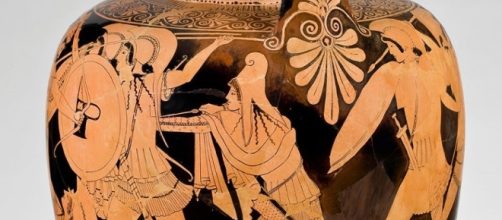Once upon a time in an ancient Mediterranean land there lived an artist who was very prolific painting pictures of people on earthenware – jars, jugs, urns -- with such grace and skill that they stood out among all the pottery paintings of his day, fifth-century Greece. Who was he? No one knows. It’s possible that this Da Vinci of vases was a slave. John Beazley, a professor of classical archaeology and art at the University of Oxford who specialized in Athenian pottery, named him the Berlin Painter because the most significant antiquities collection anywhere is held in Berlin treasure-houses – the Altes and Pergamon museums.
(Of course, naming him after a German city is like crowning, say, Salvador Dali the St. Petersburg painter because a Florida Museum collects so much of his work).
What men or gods are these?
This much we know of the mystery artist: he painted on vessels so distinctively that he has rated a one-man show at Princeton University Art Museum beginning this month. Let’s face it; most art on pottery is monotonous and boring to look at. After all, how many depictions of human figures wandering over bowls and jars can you look at? Answer: plenty if it’s the Berlin Painter’s work. He gives you a lot to look at. Not only can you see naturalistic renditions subtly conforming to the curved shape of varying stoneware, but his scenes of Greeks of old attending weddings, funerals, running races, engaging in battles, or acting out old myths also show you life in Athens 2,500 years ago.
'Ode on a Grecian Urn'
And while these painted pots were used as a container for household goods like honey, water, wine, and oil, they were also in demand for another reason that had nothing to do with utility. Homes in ancient Greece showed very little furniture, so people depended on vase paintings for their room décor, for color.
With the dark red shade of the clay, the line drawings in black, and with detailing incised into the black areas exposing the red clay and sometimes white added for accent, people got objects of art.
Beazley singled out the Berlin painter’s pictures on pottery for his artistry – his sensitive, subtle and sure-handed illustrations of human activity – even musical performances.
And the thing is, he did it all on rounded surfaces. Painting the lives of people in a persuasive way on a pot is a little like Ginger Rogers dancing with Fred Astaire on heels backward. Just as it’s easier to hoof it forward, it’s simpler to paint on a picture plane that’s flat. Perhaps when English Romantic poet John Keats lyricized his “Ode on a Grecian Urn," he was thinking of the Berlin Painter’s work.

